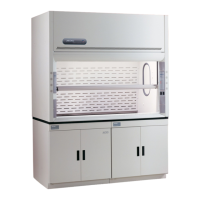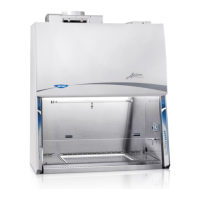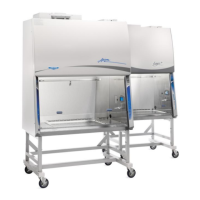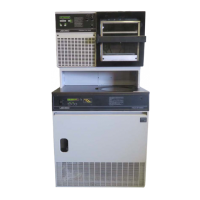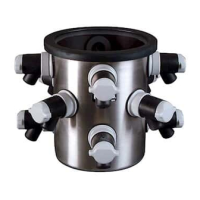Do you have a question about the Labconco Protector Premier 10040 Series and is the answer not in the manual?
Details the manual's content and structure to help users understand and use it.
Explains symbols, formatting, and icons used in the manual for clarity and comprehension.
Guides users on which chapters to read next based on their installation or operational needs.
Specifies ideal placement for the fume hood, avoiding disruptions to airflow patterns.
Outlines the necessity of permanent, stationary installation on a stable supporting structure.
Details duct connection size and airflow specifications for optimal performance.
Describes electrical connections, wiring, and power supply needs for the fume hood.
Specifies requirements for service lines such as diameter, material, and shut-off valves.
Refers to dimensions for different models, available in an appendix.
Instructions for careful removal and inspection of the fume hood upon delivery.
Procedures for safely detaching the fume hood from its shipping skid.
Describes how to release the sash weight secured for shipment.
Guidance on safely mounting the fume hood onto its support structure and work surface.
Instructions for connecting the fume hood to the building's exhaust system.
Steps for safely connecting the fume hood to the electrical power supply.
Procedures for connecting various service lines like air, water, and gas.
Method for sealing the hood to the work surface to prevent spills and leaks.
Importance and procedure for certifying the fume hood's performance.
Overview of the fume hood's design, capabilities, and unique features.
Critical guidelines for safe operation, maintenance, and handling of the fume hood.
Instructions on how to operate the hood's vertical sash mechanism.
Guidance for using the A-Style sash, including energy-saving features.
How to turn on and verify the operation of the fume hood's blower.
Simple steps to turn on and use the fume hood's internal lighting.
Best practices for planning, start-up, loading, and work techniques within the hood.
Safety measures to follow when performing maintenance or service on the fume hood.
Recommended weekly and monthly tasks for keeping the fume hood in optimal condition.
Procedures for common service tasks like front panel removal and lamp changing.
Information about installing necessary work surfaces for the fume hood.
Guidance on adding ceiling enclosures to close the gap between the hood and ceiling.
Instructions for adding rear panels for island installations.
How to install extra service fixtures in sidewalls and corner posts.
Procedures for installing airflow monitoring devices.
Guidance on installing distillation grids for mounting glassware and apparatus.
How to install a kit to restrict sash opening height.
Information on installing upper bypass for VAV systems.
Instructions for adding electrical outlets to the fume hood.
Details on installing dual exhaust adapters for specific models.
Specifies the recommended environmental parameters for operating the fume hood.
Lists the voltage, phase, cycle, and amperage ratings for the fume hood.
Lists standards and recommendations for laboratory ventilation systems.
References ACGIH guidelines on industrial ventilation and fume hood performance.
Details the ASHRAE standard for testing fume hood containment characteristics.
Specific instructions for determining opening area for certain model numbers.
Details the manual's content and structure to help users understand and use it.
Explains symbols, formatting, and icons used in the manual for clarity and comprehension.
Guides users on which chapters to read next based on their installation or operational needs.
Specifies ideal placement for the fume hood, avoiding disruptions to airflow patterns.
Outlines the necessity of permanent, stationary installation on a stable supporting structure.
Details duct connection size and airflow specifications for optimal performance.
Describes electrical connections, wiring, and power supply needs for the fume hood.
Specifies requirements for service lines such as diameter, material, and shut-off valves.
Refers to dimensions for different models, available in an appendix.
Instructions for careful removal and inspection of the fume hood upon delivery.
Procedures for safely detaching the fume hood from its shipping skid.
Describes how to release the sash weight secured for shipment.
Guidance on safely mounting the fume hood onto its support structure and work surface.
Instructions for connecting the fume hood to the building's exhaust system.
Steps for safely connecting the fume hood to the electrical power supply.
Procedures for connecting various service lines like air, water, and gas.
Method for sealing the hood to the work surface to prevent spills and leaks.
Importance and procedure for certifying the fume hood's performance.
Overview of the fume hood's design, capabilities, and unique features.
Critical guidelines for safe operation, maintenance, and handling of the fume hood.
Instructions on how to operate the hood's vertical sash mechanism.
Guidance for using the A-Style sash, including energy-saving features.
How to turn on and verify the operation of the fume hood's blower.
Simple steps to turn on and use the fume hood's internal lighting.
Best practices for planning, start-up, loading, and work techniques within the hood.
Safety measures to follow when performing maintenance or service on the fume hood.
Recommended weekly and monthly tasks for keeping the fume hood in optimal condition.
Procedures for common service tasks like front panel removal and lamp changing.
Information about installing necessary work surfaces for the fume hood.
Guidance on adding ceiling enclosures to close the gap between the hood and ceiling.
Instructions for adding rear panels for island installations.
How to install extra service fixtures in sidewalls and corner posts.
Procedures for installing airflow monitoring devices.
Guidance on installing distillation grids for mounting glassware and apparatus.
How to install a kit to restrict sash opening height.
Information on installing upper bypass for VAV systems.
Instructions for adding electrical outlets to the fume hood.
Details on installing dual exhaust adapters for specific models.
Specifies the recommended environmental parameters for operating the fume hood.
Lists the voltage, phase, cycle, and amperage ratings for the fume hood.
Lists standards and recommendations for laboratory ventilation systems.
References ACGIH guidelines on industrial ventilation and fume hood performance.
Details the ASHRAE standard for testing fume hood containment characteristics.
Specific instructions for determining opening area for certain model numbers.
| Brand | Labconco |
|---|---|
| Model | Protector Premier 10040 Series |
| Category | Laboratory Equipment |
| Language | English |

